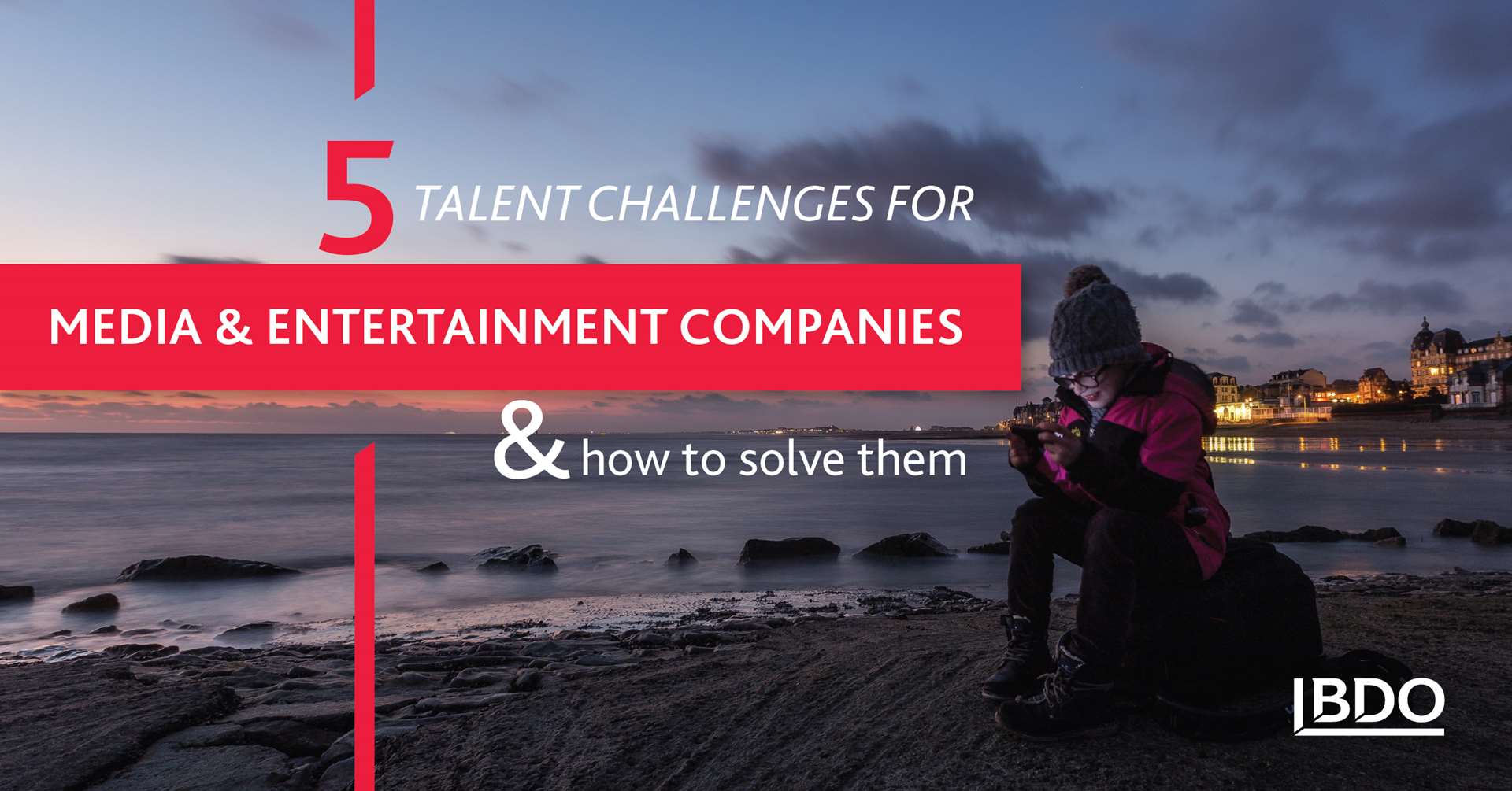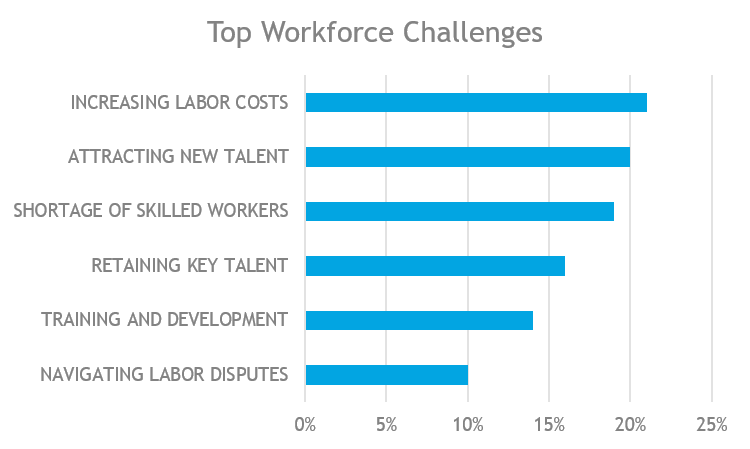Five Talent Challenges for Media & Entertainment Companies – and How to Solve Them
 Although companies across the media & entertainment sector – and related sectors - are increasingly technology-driven, people remain the pivotal power behind growth, innovation and revenue. While the competition for top talent has always been intense, the advent of a new decade is defined by a series of especially tricky challenges.
Although companies across the media & entertainment sector – and related sectors - are increasingly technology-driven, people remain the pivotal power behind growth, innovation and revenue. While the competition for top talent has always been intense, the advent of a new decade is defined by a series of especially tricky challenges.
As illustrated by the recent BDO Technology CFO Outlook Survey, companies in the Media & Entertainment, Telecommunications and Technology (TMT) sphere view finding and retaining skilled employees as core to taking advantage of opportunities for growth. A vast majority of the tech CFOs (81%) surveyed are either actively working on, or developing plans to, increase company headcount in the next 12 months. Nearly three in four (71%) interviewed CFOs mention increased spending on HR/talent departments as a means to make their strategy successful.

Top labour force challenges identified by CFOs in the BDO Tech CFO Survey. Data and graph: BDO Global
Even with increased funding, most HR departments will need a combination of innovation and new talent strategies to overcome the challenges they are facing.
Tech Workforce Strategies Point to The Future
When it comes to attracting, training and making the best possible use of available talent, the TMT sectors have often pioneered innovations that later spread to other industries. Global freelancing platforms like UpWork and Fiverr are some of the latest examples. The 2020s are sure to see further disruption as companies continue their quest to optimize use of available resources, time and talent.
An examination of current challenges and strategies in the technology sector may illuminate likely coming developments in other industries. As can be seen in the recent BDO tech CFO survey, companies are, among other things, looking to increase headcount, automate processes and robotic process automation (RPA).
| |
Currently Employing
|
Planning to Employ in Next 12 Months
|
|
INCREASING HEADCOUNT
|
52%
|
29%
|
|
DECREASING HEADCOUNT
|
32%
|
31%
|
|
AUTOMATING PROCESSES
|
54%
|
34%
|
|
OUTSOURCING OVERSEAS
|
32%
|
38%
|
|
INSOURCING
|
53%
|
34%
|
|
CO-SOURCING
|
41%
|
47%
|
|
UPSKILLING/RESKILLING
|
47%
|
42%
|
|
ROBOTICS PROCESS AUTOMATION (RPA)
|
37%
|
42%
|
Strategies to increase efficiency identified in the BDO Tech CFO Survey. Data: BDO Tech CFO Survey. Graph: BDO Global
In the vibrant media & entertainment sector in California, I see similar initiatives and strategies. For example, in relation to the rising importance of data, which requires either recruitment of new kinds of talent or upskilling existing employees. My colleagues working closely with the technology, telecommunications and life sciences industries throughout our national and international BDO network report similar scenarios.
The following five challenges represent some of the issues facing many companies throughout the sphere and beyond. I have tried to add ideas on how such challenges may be overcome.
Challenge 1: Competing for a Scarce Resource
Demographic pressures, leading to a shallower talent pool, are increasingly felt by companies across the globe, intensifying the competition for skilled employees. Something that also applies to companies in the TMT space.
A self-diagnosed sub-par performance further complicates matters. In a McKinsey study, more than eight out of ten surveyed Fortune 500 executives said that their companies struggle with recruiting and retaining highly talented and high-performing employees. The same applies to SME companies (as defined by the U.S. Small Business Administration).
One possible remedy is strategies aimed at further integrating company values and culture into how employees are hired, trained, and promoted. In other words, embedding meaning and value into every part of the work environment.
Furthermore, new technologies, such as Robotic Process Automation (RPA) and AI, should not be introduced and integrated as a means of reducing headcount. Instead, the strategy for integrating new technologies should focus on how they enable employees to concentrate on tasks and areas they are passionate about – and where they can have the most significant positive impact on company performance.
Challenge 2: Addressing the Millennial Question
The shifting demographics also leads to a need to combine diverse generations with different value sets and work style preferences. Boomers, Generation X’ers and Millennials each have their approach to work and ideas about work-life balance. Similar issues surround preferred communication methods and frequencies.
In his much-famed interview, author and RAND Corporation adjunct Simon Sinek addressed Millennials’ wants, desires and management requirements, and some of the strategies that can help companies better train and manage this group of employees.
https://www.youtube.com/watch?v=hER0Qp6QJNU
This employee segment is especially important for future-proofing operations. They will constitute a whopping 75% of the workforce by 2025. Worryingly, they are much more likely to quit their current job within two years. As a group, Millennials value professional and personal growth, a sense of purpose, high-quality management and chances of advancement.
Addressing such needs should be a priority for company HR and management efforts. For example, increased time spent on feedback, career planning and building a sense of community will not only be appreciated but may improve companies’ ability to retain talent.
Furthermore, incentive structures are often outdated. While most employees now work in teams, and project-based, this is often not reflected in leadership, job, and reward structures. For example, companies may want to look to tie rewards such as bonuses or time off to group performance, measured on a monthly, quarterly or yearly basis.
Challenge 3: Efficiently Upskilling of Employees
In a constantly evolving market, life-long learning is a cornerstone for businesses. Finding the optimal ways of upskilling or reskilling existing employees is ranks in the top three for tech CFO’s current and coming initiatives. With a looming shortfall of 4.3 million workers by 2030 in the TMT space, the same applies to media & entertainment and telecoms companies.
Organisations are often faced with a dilemma. Making time for structured training programmes often encroaches on already jam-packed calendars, lowering the efficiency of both work and training. Moreover, aligning schedules for group lessons is often almost impossible. Integrating new, more flexible ways of furthering skill sets and delivering training is needed.
We have seen great examples of technology enabling this in the healthcare sector through the use of virtual human patients to train soft skills and diagnosing.
The same is starting to spread to areas such as management and HR. Perhaps the most famous example is Barry, a VR human character that managers can practice firing. I expect to see the use of VR training to increase dramatically in coming years. The same goes for remote training.
In both cases, one of the most persuasive arguments is that new technology allows learners to slot courses and case study work into their existing schedule, instead of having to move things around to make room for them.
Challenge 4: Integrating the ‘Alternative’ Workforce
Although it is akin to asking Elon Musk if he thinks electric cars are the future, a report from the freelance platform Upwork on the popularity of freelancers includes a number of interesting points. Perhaps the most noteworthy is that as many as 55 million Americans are freelancing. That equals 16% of the entire population.
In other words, the alternative workforce has gone mainstream.
While companies are increasingly relying on freelancers, most are continuing to employ them on a project by project basis. There can be several good reasons for this approach. For example, using freelancers on an ad hoc basis enables companies to manage costs in real-time. It also solves short-term staffing uncertainties, allows for more flexibility and lowering of overall costs; something that can be particularly useful in periods leading up to potential M&A activity.
However, few companies have initiated strategies, not to mention formal programmes, aimed at maximizing the long-term value-add of freelancers. Developing alternative workforce strategies could include training programmes and formal processes for onboarding skilled freelancers via part-time or full-time contracts. Without such processes, companies may be at risk of losing valuable experience, should their preferred freelancers find better opportunities elsewhere.
Furthermore, companies may stand to benefit from introducing new technological solutions, such as workforce management suites to help efficiently manage hourly-paid workers.
Challenge 5: Staying ‘Human’
Richard Branson was once asked what the secret to a successful business was. “Train people well enough so they can leave, treat them well enough so they don’t want to,” was part of his response.
However, it seems like the sentiment of this sentence places control in the hands of the employers, which is no longer the case. Over the last four to five years, there has been a clear shift toward skilled employees holding more power in contract negotiations. Even though there is a potential economic downturn waiting in the wings, that is not likely to change. In other words, there is a need for companies across all industries to adapt to this new norm.
Confronted by increased competition for skilled employees, changing workforce demands, the need to incorporate life-long learning, and efficient integration of alternative workforce elements, companies need to adapt their processes and strategies. Technology will invariably be part of the response to such challenges.
However, just as people remain the pivotal power behind growth, innovation and revenue, human relations remain pivotal for attracting and retaining talent.
Keeping that human element in interactions, culture building, finding and retaining employees, as well as in daily management while integrating new technological solutions will be a challenge for HR and management throughout the coming decade.